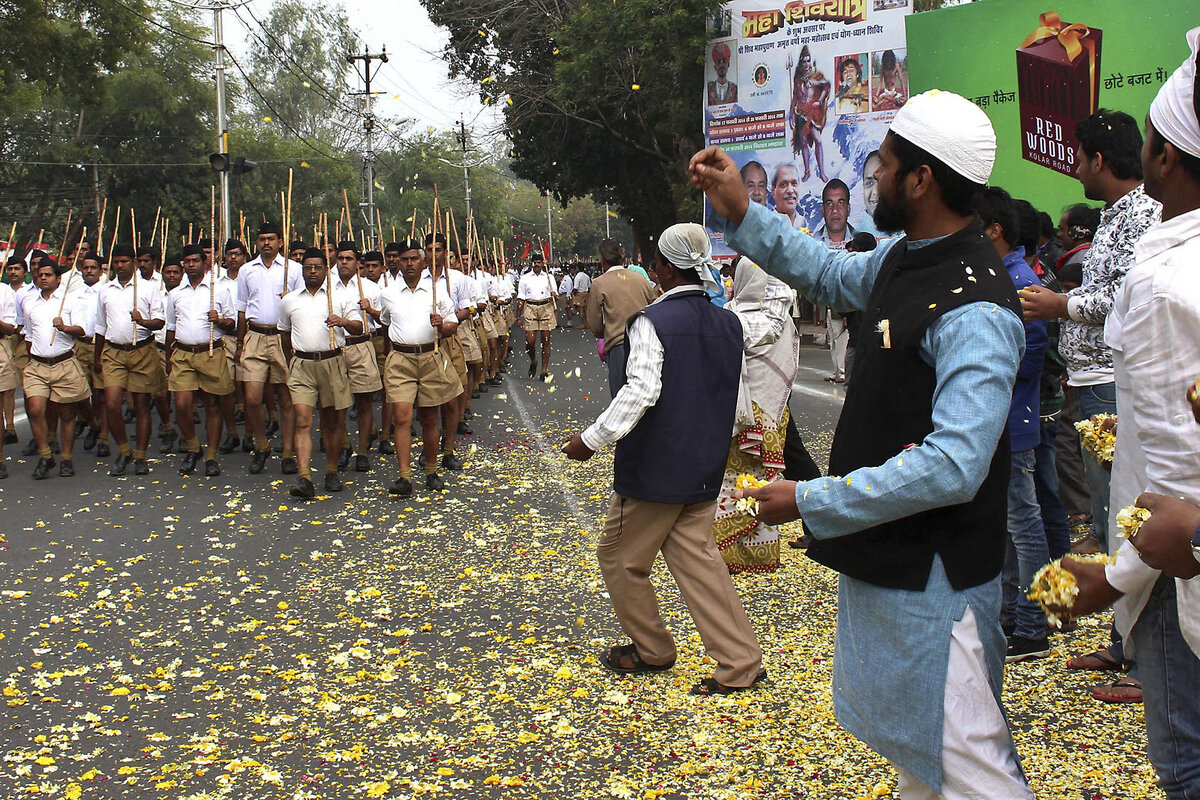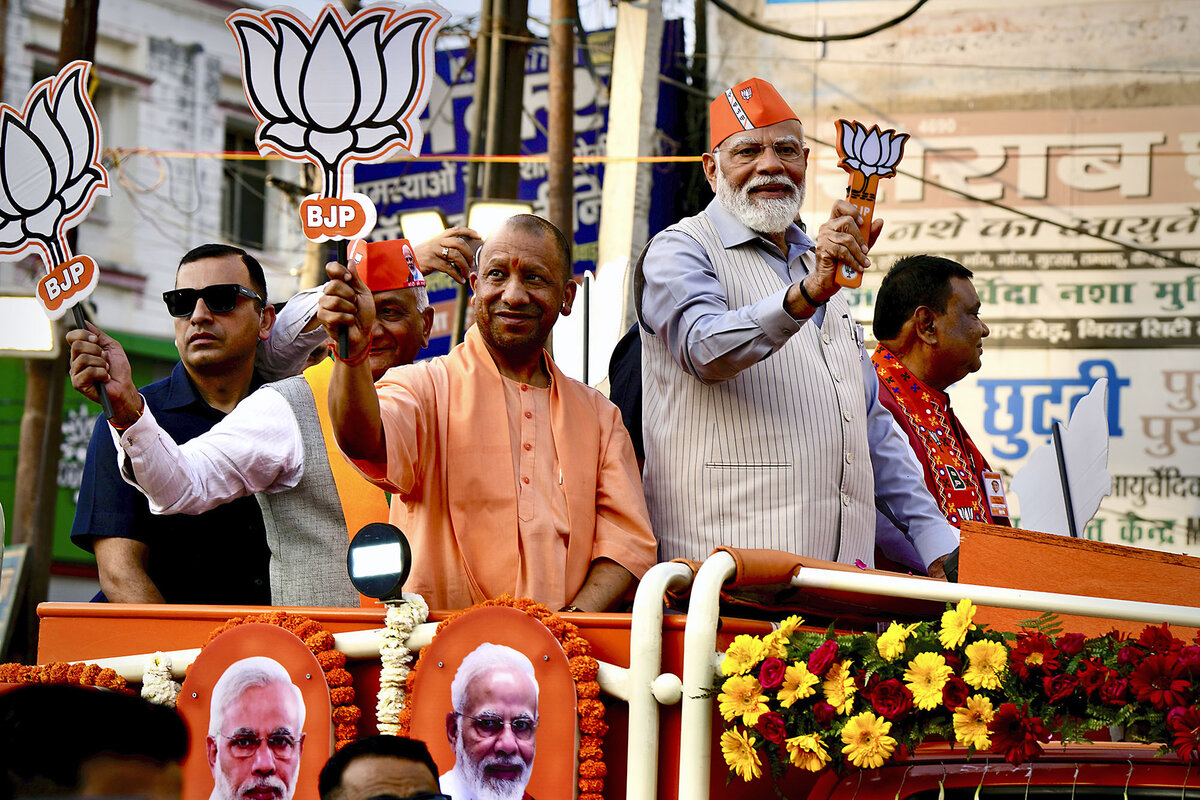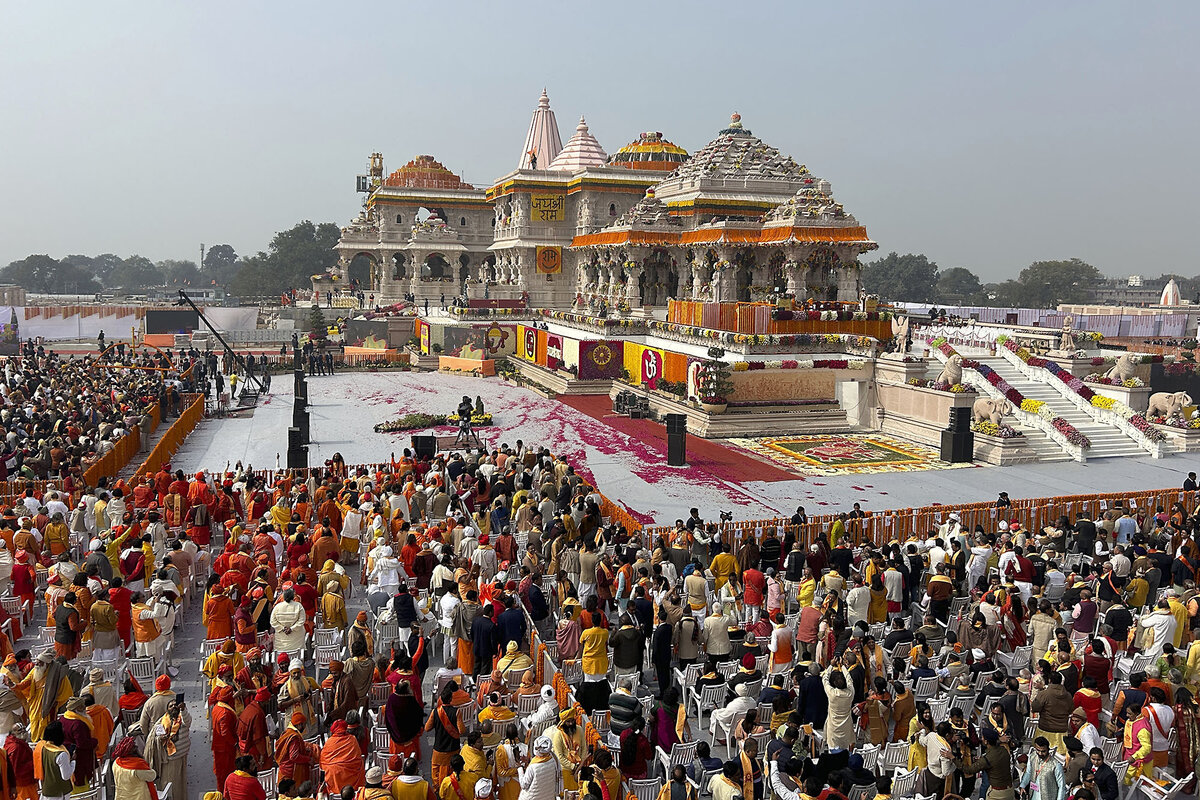In pivotal India elections, a once-radical ideology could propel Modi to a third term
Loading...
| Meerut, India
Ramesh Singh had been waiting for this day for five years. Indian Prime Minister Narendra Modi has made it a tradition to kick off general election campaigns in Mr. Singh’s city, and this year was no different. So the sugarcane farmer joined the adoring throngs, who are all but guaranteed to deliver Mr. Modi a resounding third-term victory in elections that begin Friday.
“Modi is not just a leader for us; he is like our god. He is the savior of Hindus,” says Mr. Singh, who was at the front of the crowd, waving the flag of Mr. Modi’s Bharatiya Janata Party (BJP), during the campaign rally last month. “I will make sure everyone in my family and relatives votes for Modi’s party.”
As the world’s largest election gets underway, Mr. Modi’s brand of nationalist politics is on full display, signaling even more division ahead for India’s diverse population. The prime minister reached near deity status among his supporters in large part by leveraging Hindutva, a once-fringe political ideology that equates “Indianness” with “Hinduness.” It thrives on the belief – credible or not – that Hindu culture is under threat, and aims to establish Hindu hegemony. Policies implemented over the past decade have resulted in the persecution of India’s large Muslim minority, and pushed the country, founded on democratic and secular values, on the path to becoming a Hindu nation.
Why We Wrote This
A story focused onPrime Minister Narendra Modi is expected to easily win a third term during India’s general election. The engine of his popularity? A long-standing ideology that seeks to transform India from a secular nation into a Hindu one.
Some experts say India’s already there.
“There are laws that the Modi government has made that are clearly discriminatory and anti-Muslim, and state policies for the allocation of resources are also [biased] against Muslims and Christians,” says Apoorvanand, a political commentator and professor from the University of Delhi’s Hindi Department, who, like many in India, uses only one name. “It has become, in all practical senses, a Hindu-first state.”
An ideology that predates modern India
The Hindutva ideology was first described by Indian political activist Vinayak Damodar Savarkar in 1922, while in prison for opposing British colonial rule.
It’s based on a view of the subcontinent’s history not as a crossroads of different religions and cultures, but as a Hindu land under constant invasion – by Islamic forces, Christian missionaries, and British imperialists. Indian independence, through the Hindutva lens, meant liberating Hindus from all these outside forces.
Many historians say this history is flawed, erasing centuries of peaceful coexistence between different religions and portraying Hindu culture as monolithic.
“The basic element in their ideology is that only those whose fatherland and Punya Bhoomi [land of worship] are in India are Indians, which means Christians and Muslims are foreigners,” says Aditya Mukherjee, professor of contemporary Indian history at Jawaharlal Nehru University. “This is what false consciousness is. You create a memory, and you create a consciousness that does not exist.”
Savarkar’s teachings inspired the creation of the Rashtriya Swayamsevak Sangh (RSS), a Hindu nationalist volunteer organization. Its members admired European fascism and were early supporters of the “two-nation theory,” which advocated for partitioning post-colonial British India into a state for Muslims (Pakistan) and a state for Hindus (Hindustan).
But India’s founders, including Mahatma Gandhi, “thought that this was an absurd and pro-colonial idea,” says Professor Mukherjee. The movement to create Pakistan succeeded, but in India, leaders instead established a secular democracy that sought to embrace religious pluralism, and Hindutva politicians were pushed to the fringes.
“In the first election [held 1951-1952], they got 6% of the votes,” says Professor Mukherjee. “Ninety-four percent of the Indian people said we don’t want … a mirror image of Muslim Pakistan. We want a secular India.”
In the following decades, India’s dominant political party, the centrist Indian National Congress, worked to limit the RSS’s influence. When a Hindutva activist and RSS member assassinated Gandhi during a multifaith prayer meeting in 1948, the government imposed a year-long ban against the group – one of several during the country’s early history.
But since then, Hindutva leaders have also been working – often quietly – to rebuild their power. RSS members have opened more than 20,000 schools that teach a Hindu nationalist version of Indian history. The BJP, founded in 1980 as the RSS’s political arm, brought Hindutva ideas back into mainstream politics by allying with various parties trying to dislodge Congress.
Helmed by Mr. Modi, who served as an RSS volunteer throughout his youth, the BJP has completed this mission. Last elections, the party swept votes, winning 303 out of 543 parliamentary seats, and Congress remains on the back-foot today. Over the past decade, the Modi administration has rallied Hindu nationalists and advanced the Hindutva agenda nationwide.
This includes revoking Article 370, which granted the Muslim-majority region of Kashmir special autonomy; advocating for a uniform civil code, which would bar people from using their own religious laws to govern issues such as marriage and inheritance, as is currently allowed in India; and criminalizing the conversion of Hindus into other faiths, particularly Islam and Christianity, despite limited evidence of wide-scale, forced conversions. Human rights groups have also sounded alarms over the introduction of religion-based citizenship laws.
Hub of Hindutva
Uttar Pradesh – the country’s most populous state, and typically a bellwether for national elections – offers a glimpse into what a Hindu-first India would look like.
Here, the last 10 years have been rife with incidents of Hindu majoritarianism. Authorities have bulldozed Muslim homes and businesses, Islamic religious schools have been banned, frenzied mobs have killed Muslims suspected of eating beef, and interfaith couples have been attacked by right-wing groups. All this has the tacit or direct support of the government, headed by Hindu clerk-turned-politician Yogi Adityanath.
Earlier this year, Mr. Modi traveled to Ayodhya, located across the state from Meerut, to inaugurate the controversial Ram temple, a major Hindu nationalist rallying point. The massive temple is built on the site of a centuries-old mosque that was demolished in 1992 by a violent Hindu mob.
“People thought it would be impossible, but Ram temple was built there,” the prime minister told tens of thousands of supporters during his recent rally in Meerut. At no point during his 45-minute speech did the prime minister reassure or acknowledge religious minorities, despite 36% of Meerut’s population being Muslim.
Just weeks later, 200 Muslims were booked by police officers for offering Eid prayers on the road.
“Modi can use the entire government machinery for building Hindu temples, but they cannot tolerate Muslims praying on the day of their most important festival,” says Abdul Samad, a resident of Meerut. “It has been clear in the last ten years that the BJP wants Muslims to live as second-class citizens.”
Anwari Begum, whose husband was one of the 17 people killed during the destruction of Ayodhya mosque, agrees. “The mission of Modi’s party is to punish Muslims,” she says. “They are humiliating us every day.”
It’s a sentiment shared far beyond Uttar Pradesh. Across India, but especially in states with BJP leadership, observers say religious divisions are growing as hardline Hindutva thought goes mainstream.
Vikas Verma, a member of the RSS-affiliated vigilante group Bajrang Dal in neighboring Uttarakhand, helped spearhead a campaign last May to drive out Muslim shopkeepers over an alleged case of “love jihad” – a common conspiracy theory accusing Muslim men of luring Hindu women into marriage in order to forcibly convert them to Islam.
“We believe that Muslims are deliberately increasing their population, and they want to take over the land of Hindus,” he says, arguing that Hindus must not allow Muslims in India to pray publicly or serve Halal meat.
“They should live like Hindus do,” he says.









